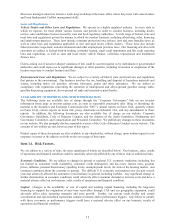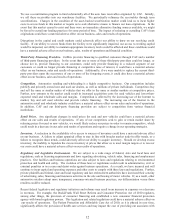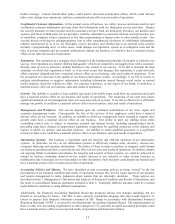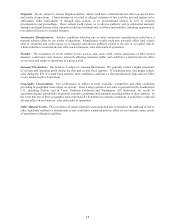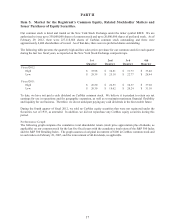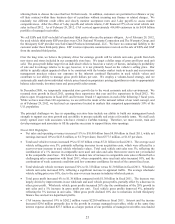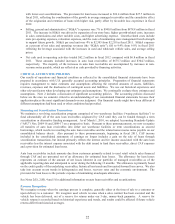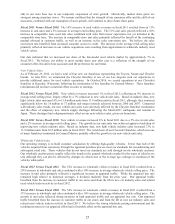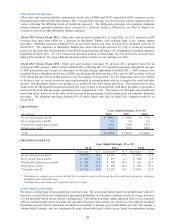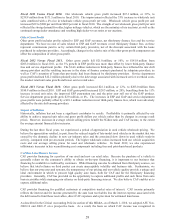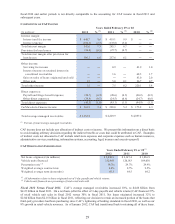CarMax 2012 Annual Report Download - page 26
Download and view the complete annual report
Please find page 26 of the 2012 CarMax annual report below. You can navigate through the pages in the report by either clicking on the pages listed below, or by using the keyword search tool below to find specific information within the annual report.20
Item 7. Management’s Discussion and Analysis of Financial Condition and Results of
Operations.
The following Management’s Discussion and Analysis of Financial Condition and Results of Operations (“MD&A”)
is provided as a supplement to, and should be read in conjunction with, our audited consolidated financial statements
and the accompanying notes presented in Item 8, Consolidated Financial Statements and Supplementary Data. Note
references are to the notes to consolidated financial statements included in Item 8. Certain prior year amounts have
been reclassified to conform to the current year’s presentation. All references to net earnings per share are to diluted
net earnings per share. Amounts and percentages may not total due to rounding.
In fiscal 2012, we revised our consolidated financial statements for fiscal 2011 and fiscal 2010 to correct our
accounting for sale-leaseback transactions. See Note 2(K) for additional information. As of March 1, 2010, we
adopted new accounting rules related to securitizations that affected the timing of the recognition of CarMax Auto
Finance (“CAF”) income and resulted in the consolidation of the auto loan receivables and related non-recourse
notes payable that previously were reflected as off-balance sheet items. The new rules were adopted on a
prospective basis and prior year balances have not been restated. See Notes 2(E), 3, 4 and 5 for additional
information.
BUSINESS OVERVIEW
General
CarMax is the nation’s largest retailer of used vehicles. We pioneered the used car superstore concept, opening our
first store in 1993. Our strategy is to revolutionize the auto retailing market by addressing the major sources of
customer dissatisfaction with traditional auto retailers and to maximize operating efficiencies through the use of
standardized operating procedures and store formats enhanced by sophisticated, proprietary management
information systems. As of February 29, 2012, we operated 108 used car superstores in 53 markets, comprising 41
mid-sized markets, 11 large markets and 1 small market. We define mid-sized markets as those with television
viewing populations generally between 600,000 and 2.5 million people. We also operated four new car franchises.
During fiscal 2012, we sold 408,080 used cars, representing 98% of the total 415,759 vehicles we sold at retail.
We believe the CarMax consumer offer is distinctive within the auto retailing marketplace. Our offer provides
customers the opportunity to shop for vehicles the same way they shop for items at other big box retailers. Our
consumer offer is structured around our four customer benefits: low, no-haggle prices; a broad selection; high
quality vehicles; and a customer-friendly sales process. Our website, carmax.com, is a valuable tool for
communicating the CarMax consumer offer, a sophisticated search engine and an efficient channel for customers
who prefer to conduct their shopping online. We generate revenues, income and cash flows primarily by retailing
used vehicles and associated items including vehicle financing, extended service plans (“ESPs”), a guaranteed asset
protection (“GAP”) product and vehicle repair service. GAP is designed to cover the unpaid balance on an auto loan
in the event of a total loss of the vehicle or unrecovered theft.
We also generate revenues, income and cash flows from the sale of vehicles purchased through our appraisal process
that do not meet our retail standards. These vehicles are sold through on-site wholesale auctions. Wholesale
auctions are generally held on a weekly or bi-weekly basis, and as of February 29, 2012, we conducted auctions at
52 used car superstores. During fiscal 2012, we sold 316,649 wholesale vehicles. On average, the vehicles we
wholesale are approximately 10 years old and have more than 100,000 miles. Participation in our wholesale
auctions is restricted to licensed automobile dealers, the majority of whom are independent dealers and licensed
wholesalers.
CarMax provides financing to qualified retail customers through CAF, our finance operation, and our arrangements
with several industry-leading financial institutions. As of February 29, 2012, these third parties included Capital
One Auto Finance, Santander Consumer USA, Wells Fargo Dealer Services and American Credit Acceptance.
Third-party providers purchasing subprime finance contracts generally purchase these contracts at a discount, while
providers purchasing prime and non-prime finance contracts generally pay us a fixed, pre-negotiated fee per
contract. We periodically test additional third-party providers. We have no recourse liability on retail installment
contracts arranged with third-party providers.
We offer financing through CAF to qualified customers purchasing vehicles at CarMax. CAF utilizes proprietary
customized scoring models based upon the credit history of the customer, along with CAF’s historical experience, to
predict the likelihood of customer repayment. CAF offers customers an array of competitive rates and terms,



